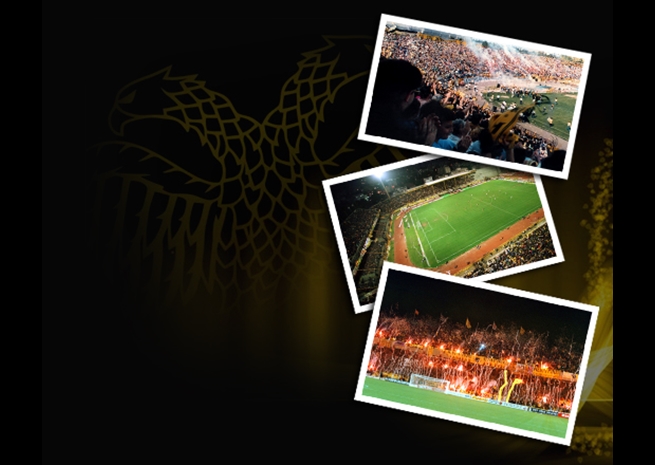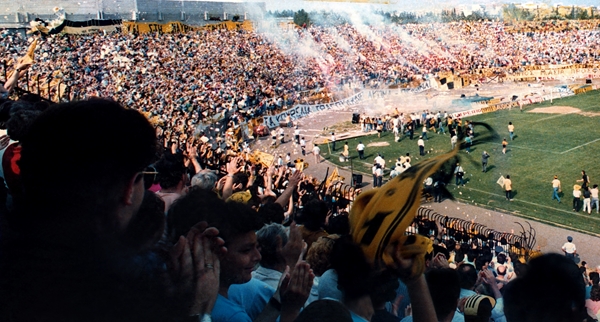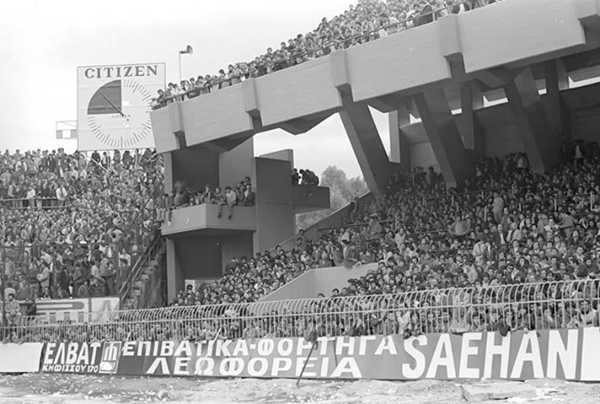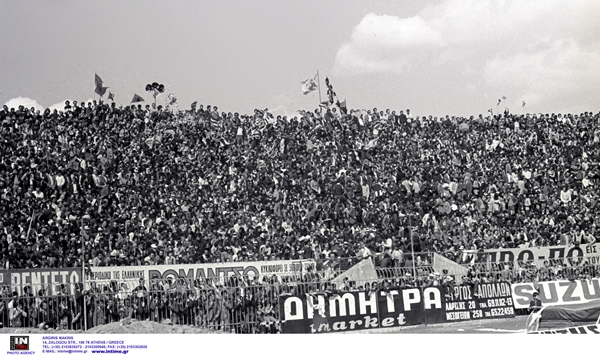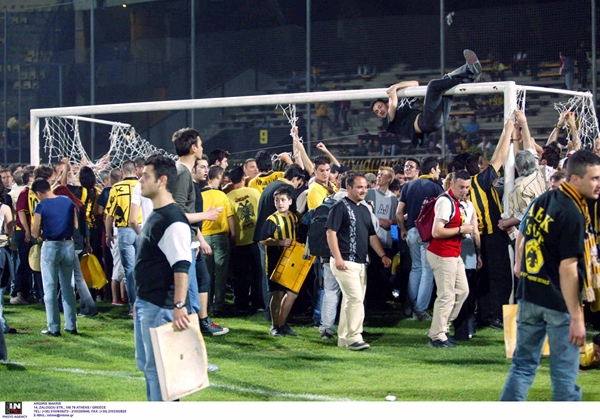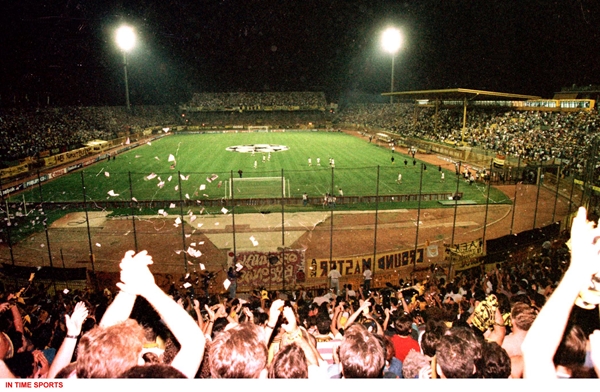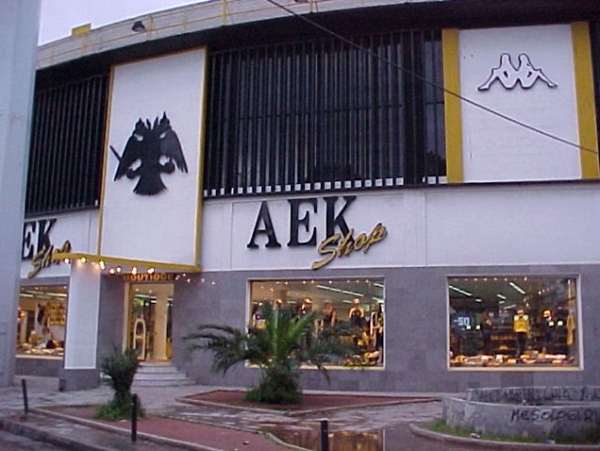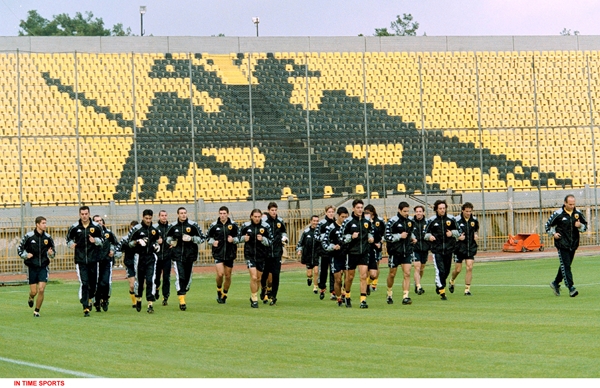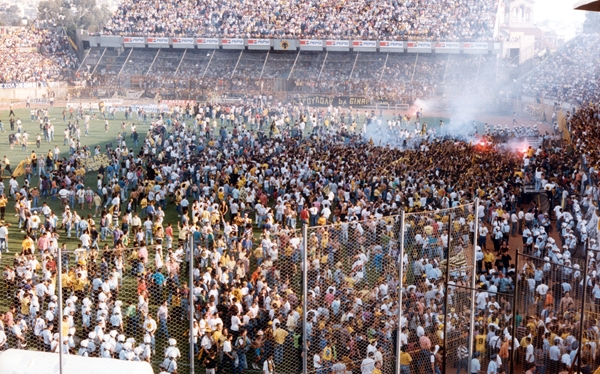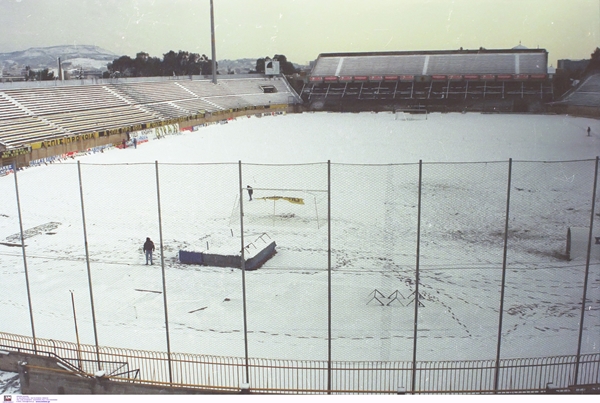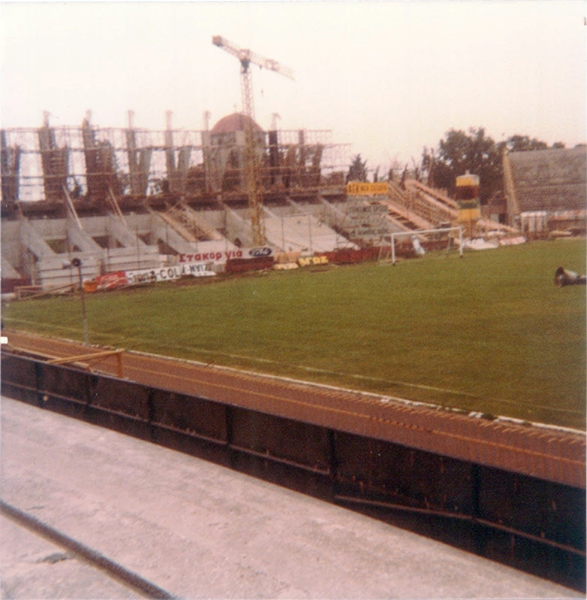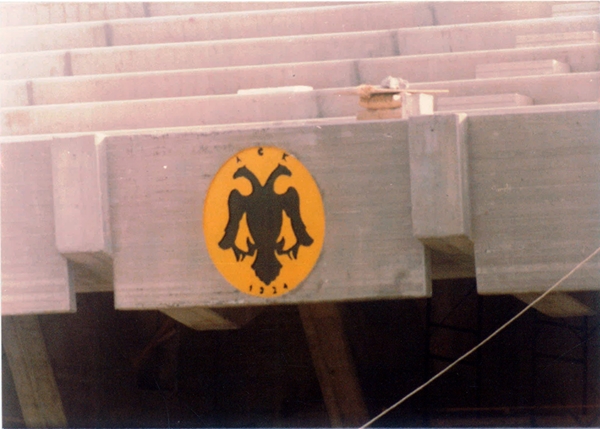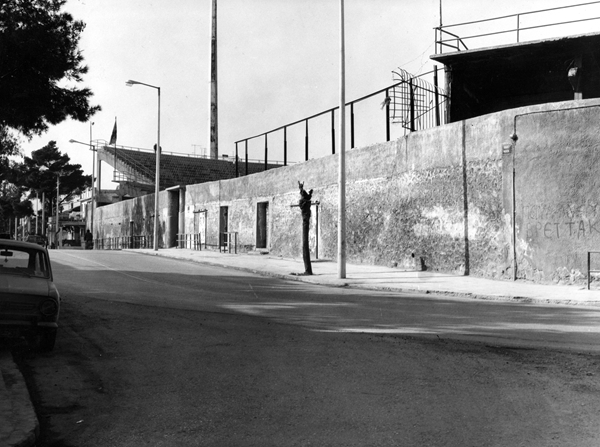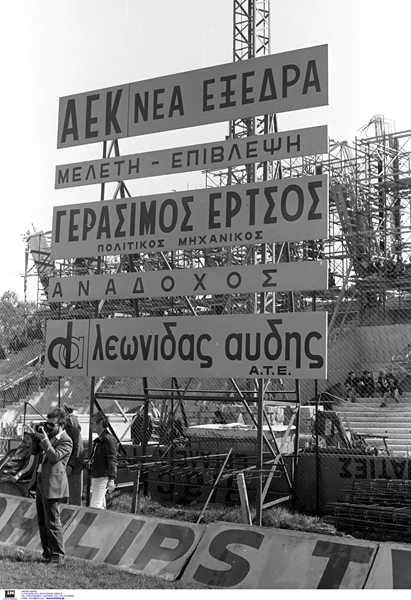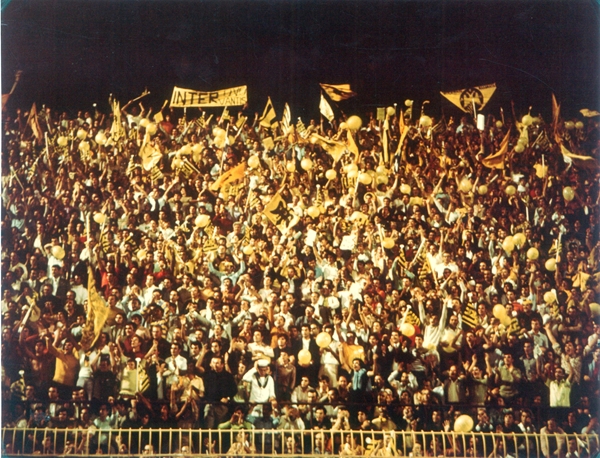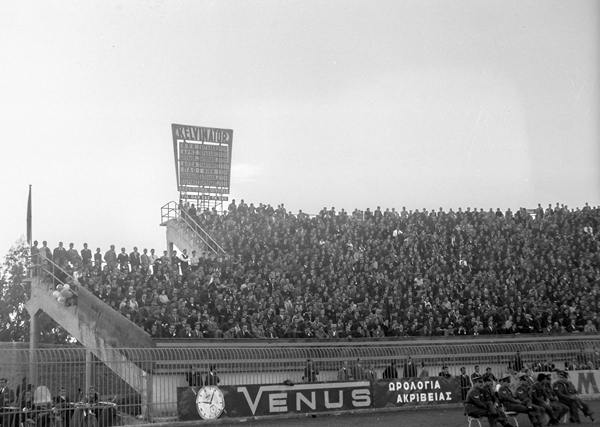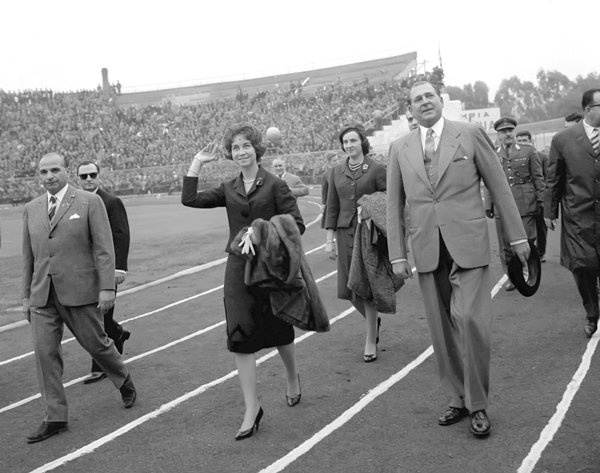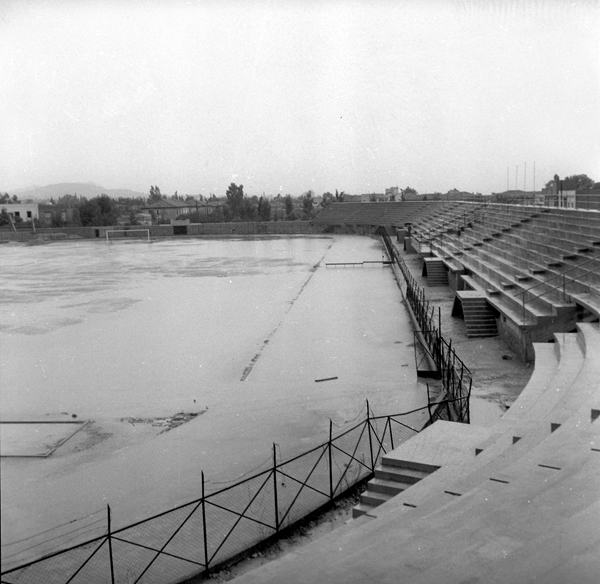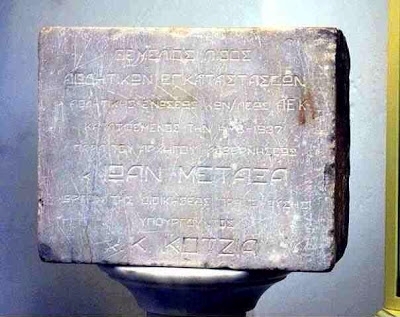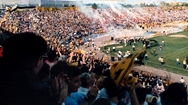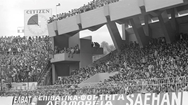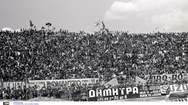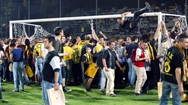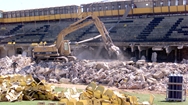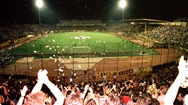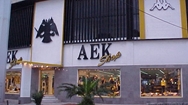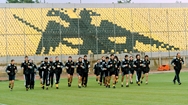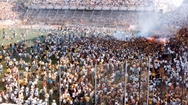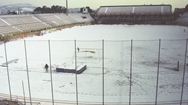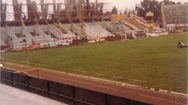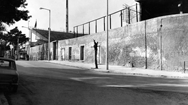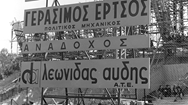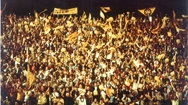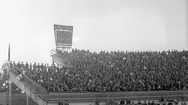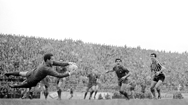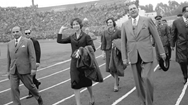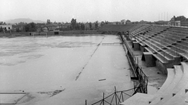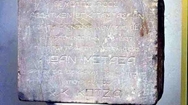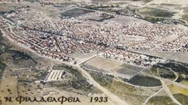To view the desktop site, press the "View the desktop site" button at the bottom of the page
OUR OLD HOME "NIKOS GOUMAS" \\
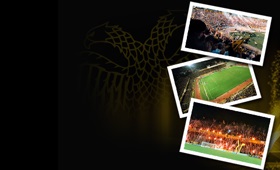
For almost eighty years, from the 1926 open sand lot until the 2003 demolition of the club's stadium, AEK FC has done some great deeds. This is our home. Forever and ever!
The first step to make a dream come true was made in 1926 -with the help of Ioannis Chrysafidis, who was an advisor at the Central Committee for Refugee Accommodation- when a tree-covered plot in Podoniftis area, or Nea Filadelphia as it is currently called, was given as a training ground for the refugees. What used to be a tree-covered and rough land was turned overnight, thanks to the work of refugees, into a proper pitch and thus protected from being occupied by homeless refugees.
However, the decisive step for the land to be signed over to AEK was taken in 1929. One of the founders of AEK (or Enosis) and its first President, Konstantinos Spanoudis, intervened personally towards Eleftherios Venizelos in order for the pitch to be granted to AEK by the Ministry of Welfare. On November 2, 1930, the venue was officially inaugurated on the occasion of an exhibition match between AEK and Olympiacos. Two goals by Ilias Iliaskos and another double by Vassilis Andrianopoulos led to the final 2-2, in a match played before the then Mayor and Minister of Administration of Athens, Konstantinos Kotzias, and a big number of officials.
During its first 10 years of operation, AEK's ground was not suitable to host matches, and also located too far from Athens' urban centre of the time. But in 1934, Konstantinos Kotzias assisted in granting the Nea Filadelphia venue the status of eligibility. The track was built, railings were fitted and now AEK could host matches, despite the fact that there were no stands yet! It is not by accident that the titles of the years 1938-40 were won in Nea Filadelphia and not in the pitches of Leoforos Alexandras or Rouf that accommodated AEK until 1937.
The sand lot was turned into a palace!
The war actually interrupted the saga of AEK's fantastic team, which -in one of its last performances in a friendly on September 29, 1940 (in the aftermath of two consecutive championship titles and one double) crashed Olympiacos by 7-3.
During the war, the venue was looted by the Italian occupation forces stationed there. Nevertheless, right after liberation, life in AEK's ground resumed and the venue started to expand. A friend of AEK of substantial social involvement in those difficult years, Spiros Skouras, helped in his capacity as the club's president, in 1945, to build permanent fencing around the pitch. The upgrade was finished one year later under the presidency of Aimilios Ionas, one the club's founders. In fact, it was in 1946 when the first stands were built towards the park side, where Gate 3 used to be for decades.
The vision of Nikos Gkoumas
In the 1950s, Nea Filadelphia used to have 2 main entrances and one standing area. The pitch, however, was turned to a proper crown jewel thanks to the vision of a single man whose name has become a byword for AEK. Nikos Gkoumas was the man who imagined of an enviable Nea Filadelphia stadium and ultimately built it. The plan provided for a horseshoe-shaped construction with a length of 100 m, connecting two stands facing each other and thus an AEK stadium that could host up to forty thousand people, including those standing!
The opening of the venue took place on January 3, 1962, in the most official way: The great Barcelona would come to Greece, and the stands were graced by the presence of the then heir and current holder of the Spanish throne, Juan Carlos and his wife Sophia.
The mark of Loukas Mparlos
By 1971, the Nea Filadephia stadium is equipped with floodlights and thus may host matches at night, while in the late 1970s, it is the first stadium in Greece with a double-tier stand. The "Skepasti" tier (meaning "roofed"), the actual nest of AEK's ultras, was the first double-tier stand in Greece built at the expenses of Loukas Mparlos, the second of the club's historic Presidents, and developed by Gerasimos Ertsos, an engineer and member of AEK BoD.<br />It was in a derby match against Panathinaikos in November 1980 when an all-time record attendance of 36,766 tickets was registered. Gradually, the stadium's capacity was reduced. The standing area was eliminated and, due to the obligation to place proper seats on the stands, the number of seating spectators was reduced.
Nea Filadelphia in the new era
On September 7, 1991, the the roof of Gate 18 was introduced. The cost was covered by former President Nikos Gkoumas, whom the stadium was named after. In 1992, The Melissanidis-Karras administration launched a series of actions aimed at applying a facelift on the stadium. Rebuilding of dressing rooms, which for many years used to be under Gate 19, construction of a luxurious members club and a Press Room, brand new benches fitted.
In 1993, AEK FC's store, one of the biggest in Europe at that time, was built at the back of stand 16-17 and one year later, thanks to our side participating in the Champions League, this led to changes along Kappadokias street.
Last show for a historic symbol
In 1999, the destructive earthquake of September 7th took its toll on Nea Filadelphia, since the Gate 3 side had to remain closed for safety reasons until necessary cement grouting was performed. The match against Aris on May 3, 2003, was the swan song for a stadium made synonymous with all AEK achievements.
Giannis Granitsas was the...mastermind behind the demolition of the stadium, given that proceedings for building a new one on the same plot were already under way. However, various problems in terms of the plan's legal aspects, reactions by local residents and lack of resources, turned out to be insurmountable. The then President of both the FC and our amateur sports club (administration members appointed by the Court of First Instance from February 2003 until mid 2004) was too hasty to start the demolition works and he bears most of the responsibility for keeping our team homeless.
Even the new law supported by the then Deputy Minister of Sports, Giorgos Lianis, and finally passed in late 2003, was proven insufficient. Nea Filadephia, originally included in the 2004 Olympic Games dossier of venues, was finally taken out and replaced by contemporary Olympiacos stadium in Neon Faliron. AEK was hosted from May 2003 until October 2004 in various grounds, until it moved to the renovated Olympic Stadium in October 2004.
The first step to make a dream come true was made in 1926 -with the help of Ioannis Chrysafidis, who was an advisor at the Central Committee for Refugee Accommodation- when a tree-covered plot in Podoniftis area, or Nea Filadelphia as it is currently called, was given as a training ground for the refugees. What used to be a tree-covered and rough land was turned overnight, thanks to the work of refugees, into a proper pitch and thus protected from being occupied by homeless refugees.
However, the decisive step for the land to be signed over to AEK was taken in 1929. One of the founders of AEK (or Enosis) and its first President, Konstantinos Spanoudis, intervened personally towards Eleftherios Venizelos in order for the pitch to be granted to AEK by the Ministry of Welfare. On November 2, 1930, the venue was officially inaugurated on the occasion of an exhibition match between AEK and Olympiacos. Two goals by Ilias Iliaskos and another double by Vassilis Andrianopoulos led to the final 2-2, in a match played before the then Mayor and Minister of Administration of Athens, Konstantinos Kotzias, and a big number of officials.
During its first 10 years of operation, AEK's ground was not suitable to host matches, and also located too far from Athens' urban centre of the time. But in 1934, Konstantinos Kotzias assisted in granting the Nea Filadelphia venue the status of eligibility. The track was built, railings were fitted and now AEK could host matches, despite the fact that there were no stands yet! It is not by accident that the titles of the years 1938-40 were won in Nea Filadelphia and not in the pitches of Leoforos Alexandras or Rouf that accommodated AEK until 1937.
The sand lot was turned into a palace!
The war actually interrupted the saga of AEK's fantastic team, which -in one of its last performances in a friendly on September 29, 1940 (in the aftermath of two consecutive championship titles and one double) crashed Olympiacos by 7-3.
During the war, the venue was looted by the Italian occupation forces stationed there. Nevertheless, right after liberation, life in AEK's ground resumed and the venue started to expand. A friend of AEK of substantial social involvement in those difficult years, Spiros Skouras, helped in his capacity as the club's president, in 1945, to build permanent fencing around the pitch. The upgrade was finished one year later under the presidency of Aimilios Ionas, one the club's founders. In fact, it was in 1946 when the first stands were built towards the park side, where Gate 3 used to be for decades.
The vision of Nikos Gkoumas
In the 1950s, Nea Filadelphia used to have 2 main entrances and one standing area. The pitch, however, was turned to a proper crown jewel thanks to the vision of a single man whose name has become a byword for AEK. Nikos Gkoumas was the man who imagined of an enviable Nea Filadelphia stadium and ultimately built it. The plan provided for a horseshoe-shaped construction with a length of 100 m, connecting two stands facing each other and thus an AEK stadium that could host up to forty thousand people, including those standing!
The opening of the venue took place on January 3, 1962, in the most official way: The great Barcelona would come to Greece, and the stands were graced by the presence of the then heir and current holder of the Spanish throne, Juan Carlos and his wife Sophia.
The mark of Loukas Mparlos
By 1971, the Nea Filadephia stadium is equipped with floodlights and thus may host matches at night, while in the late 1970s, it is the first stadium in Greece with a double-tier stand. The "Skepasti" tier (meaning "roofed"), the actual nest of AEK's ultras, was the first double-tier stand in Greece built at the expenses of Loukas Mparlos, the second of the club's historic Presidents, and developed by Gerasimos Ertsos, an engineer and member of AEK BoD.<br />It was in a derby match against Panathinaikos in November 1980 when an all-time record attendance of 36,766 tickets was registered. Gradually, the stadium's capacity was reduced. The standing area was eliminated and, due to the obligation to place proper seats on the stands, the number of seating spectators was reduced.
Nea Filadelphia in the new era
On September 7, 1991, the the roof of Gate 18 was introduced. The cost was covered by former President Nikos Gkoumas, whom the stadium was named after. In 1992, The Melissanidis-Karras administration launched a series of actions aimed at applying a facelift on the stadium. Rebuilding of dressing rooms, which for many years used to be under Gate 19, construction of a luxurious members club and a Press Room, brand new benches fitted.
In 1993, AEK FC's store, one of the biggest in Europe at that time, was built at the back of stand 16-17 and one year later, thanks to our side participating in the Champions League, this led to changes along Kappadokias street.
Last show for a historic symbol
In 1999, the destructive earthquake of September 7th took its toll on Nea Filadelphia, since the Gate 3 side had to remain closed for safety reasons until necessary cement grouting was performed. The match against Aris on May 3, 2003, was the swan song for a stadium made synonymous with all AEK achievements.
Giannis Granitsas was the...mastermind behind the demolition of the stadium, given that proceedings for building a new one on the same plot were already under way. However, various problems in terms of the plan's legal aspects, reactions by local residents and lack of resources, turned out to be insurmountable. The then President of both the FC and our amateur sports club (administration members appointed by the Court of First Instance from February 2003 until mid 2004) was too hasty to start the demolition works and he bears most of the responsibility for keeping our team homeless.
Even the new law supported by the then Deputy Minister of Sports, Giorgos Lianis, and finally passed in late 2003, was proven insufficient. Nea Filadephia, originally included in the 2004 Olympic Games dossier of venues, was finally taken out and replaced by contemporary Olympiacos stadium in Neon Faliron. AEK was hosted from May 2003 until October 2004 in various grounds, until it moved to the renovated Olympic Stadium in October 2004.
STADIUM PLAN \\
